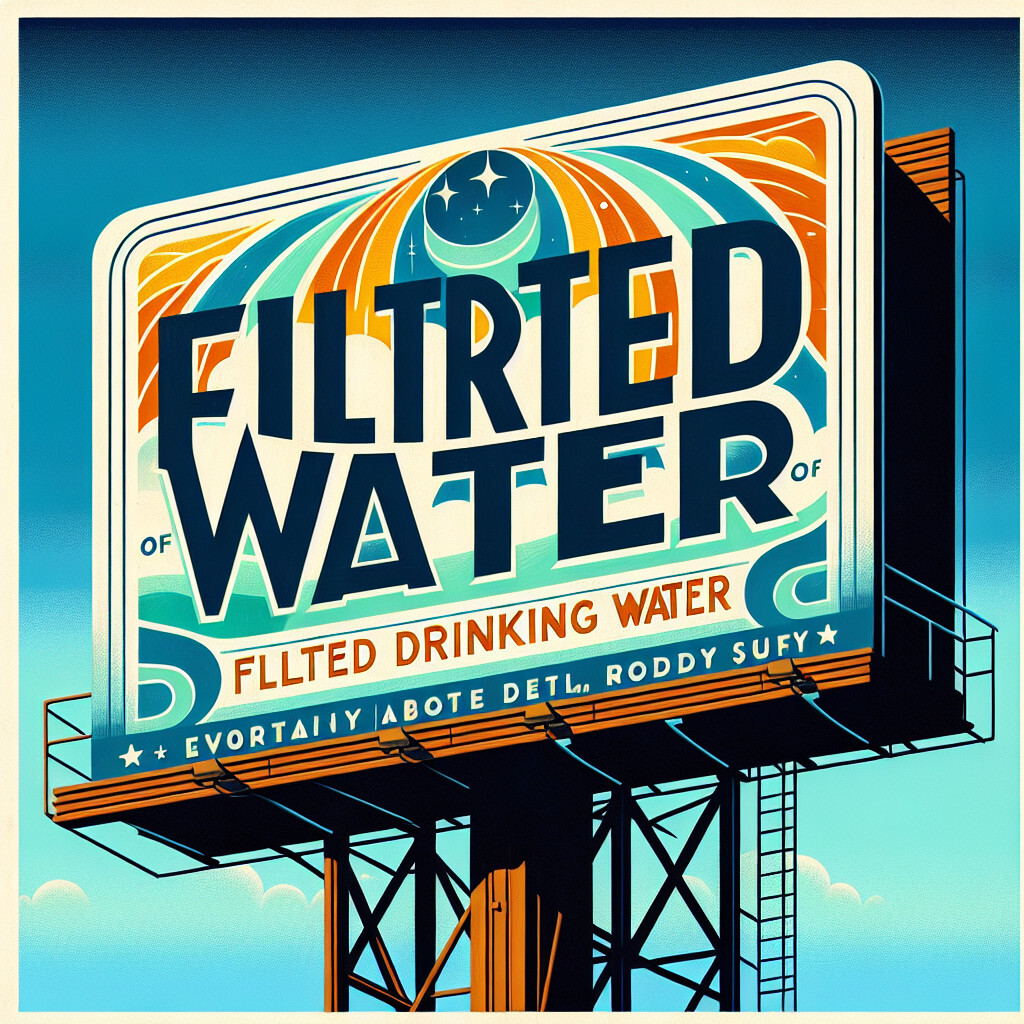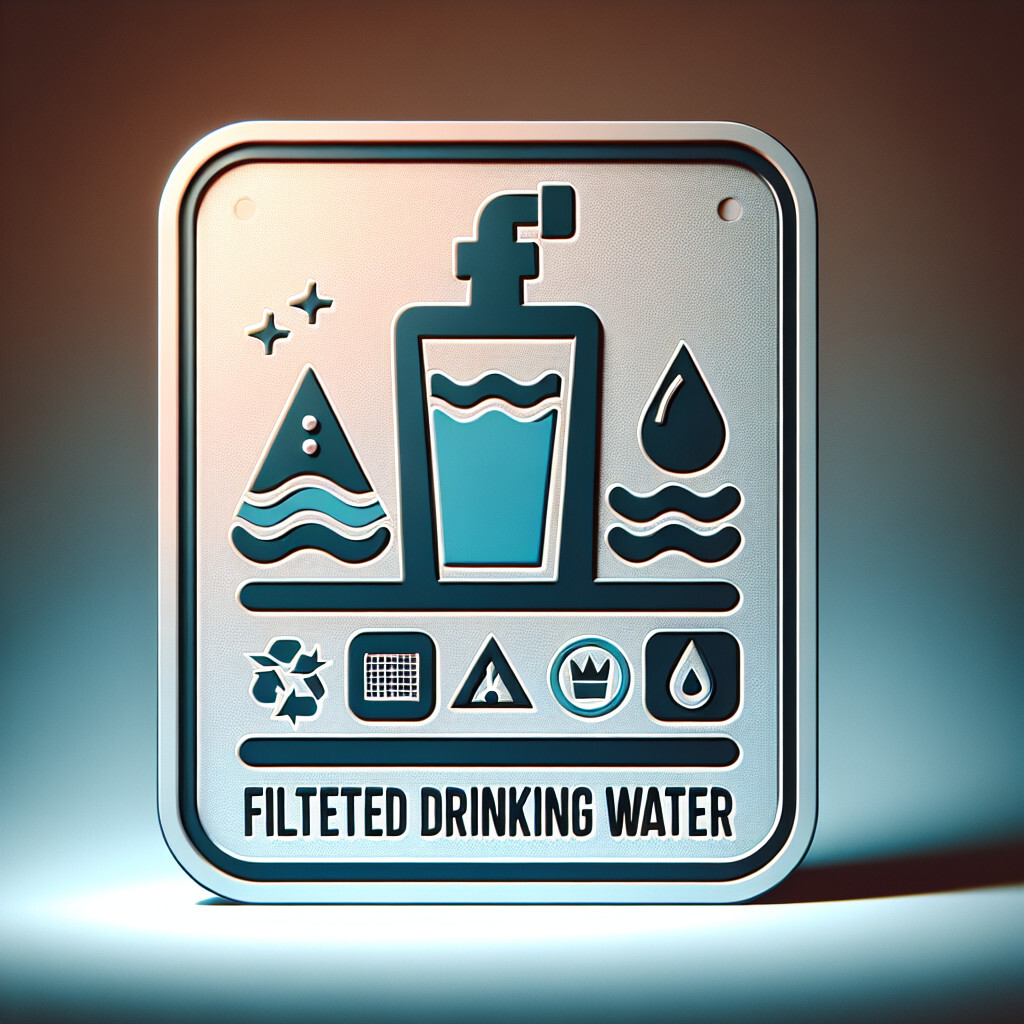-
Table of Contents
“Pure Refreshment, One Sip at a Time”
Introduction

A filtered drinking water sign is a visual indicator used in public places, offices, or homes to denote the availability of water that has undergone a filtration process to remove impurities, bacteria, and harmful substances. This sign is crucial for health and safety, ensuring that individuals have access to clean, safe drinking water. It is typically marked with universally recognized symbols or clear text to avoid language barriers and misunderstandings.
Understanding the Importance of Filtered Drinking Water Signs
The importance of filtered drinking water signs cannot be overstated. These signs serve as a critical communication tool, informing the public about the availability of clean, safe drinking water. They are especially crucial in public spaces such as parks, schools, and office buildings, where people may not have immediate access to bottled water. Understanding the significance of these signs is essential for both public health and environmental sustainability.
Filtered drinking water signs are typically displayed near water fountains or dispensers that have been equipped with a filtration system. These systems remove impurities from the water, including harmful bacteria, viruses, heavy metals, and other contaminants that can pose serious health risks. By drinking filtered water, individuals can avoid potential illnesses and improve their overall health. Therefore, these signs not only indicate the presence of a water source but also assure the public that the water is safe to consume.
Moreover, filtered drinking water signs play a pivotal role in promoting environmental sustainability. The production and disposal of plastic water bottles contribute significantly to environmental pollution. By encouraging the use of refillable water bottles at filtered water stations, these signs help to reduce plastic waste. This simple act can have a profound impact on our environment, reducing our carbon footprint and contributing to a more sustainable future.
In addition to their health and environmental benefits, filtered drinking water signs also have social implications. Access to clean drinking water is a basic human right, yet many people around the world lack this essential resource. By clearly marking the locations of filtered water sources, these signs can help to address this issue, at least in part. They ensure that everyone, regardless of their socio-economic status, has access to safe drinking water when they are in public spaces.
However, the effectiveness of filtered drinking water signs depends largely on their design. They need to be easily visible and understandable to people of all ages and backgrounds. This includes using clear, concise language and universally recognized symbols. Additionally, they should be placed in prominent locations, where they can be easily seen by those who need them.
Furthermore, it is important to maintain the quality of the filtered water sources that these signs represent. Regular testing and maintenance of the filtration systems are necessary to ensure that they continue to provide safe, clean drinking water. If a system is found to be faulty, it should be repaired or replaced immediately, and the public should be informed accordingly.
In conclusion, filtered drinking water signs are an essential tool for promoting public health, environmental sustainability, and social equality. They inform the public about the availability of safe drinking water, encourage the use of refillable water bottles, and ensure that everyone has access to this vital resource. However, their effectiveness depends on their design and the quality of the water sources they represent. Therefore, it is crucial to invest in clear, well-placed signs and regular maintenance of filtration systems. By doing so, we can help to create a healthier, more sustainable, and more equitable world.
The Role of Filtered Drinking Water Signs in Public Health
Filtered drinking water signs play a crucial role in public health, serving as a beacon of safety and assurance for the public. These signs are more than just markers; they are a testament to the commitment of public health officials and organizations to ensure the availability of clean, safe drinking water for everyone.
The importance of filtered drinking water cannot be overstated. Water is a fundamental human need, and its quality directly impacts our health. Contaminated water can lead to a host of diseases, including cholera, dysentery, and typhoid. Therefore, the provision of filtered drinking water is a critical public health measure.
Filtered drinking water signs serve as a clear, visible indicator that the water provided has been treated and is safe for consumption. They are typically placed in public places such as parks, schools, and community centers, where people gather and may need to hydrate. These signs are especially important in areas where the quality of tap water may be questionable, providing a reliable source of safe drinking water.
Moreover, these signs also play an educational role. They raise awareness about the importance of drinking filtered water and the potential health risks associated with consuming untreated water. This is particularly significant in regions where access to clean water may be limited, and people may not be aware of the dangers of drinking unfiltered water.
In addition to their educational role, filtered drinking water signs also serve a regulatory function. They are a part of the broader public health infrastructure, ensuring compliance with health and safety standards. These signs indicate that the water source has been tested and meets the necessary quality standards. This not only provides reassurance to the public but also holds providers accountable, ensuring they maintain the quality of the water supply.
Furthermore, filtered drinking water signs can also play a role in emergency situations. In the aftermath of natural disasters such as floods or earthquakes, when regular water supplies may be disrupted, these signs can guide people to safe drinking water sources. This can be life-saving in situations where access to clean water is compromised.
However, the effectiveness of filtered drinking water signs in promoting public health is contingent on their visibility and clarity. The signs need to be prominently displayed and easily understandable. They should clearly indicate that the water is filtered and safe for drinking. In multilingual communities, the signs should be in multiple languages to ensure that everyone can understand them.
In conclusion, filtered drinking water signs are an essential tool in public health. They provide a visible assurance of safe drinking water, educate the public about the importance of water quality, ensure compliance with health standards, and can be a vital resource in emergencies. As such, they are a testament to the commitment of public health officials and organizations to safeguard the health of the public. Their role in promoting public health underscores the importance of maintaining and enhancing this vital infrastructure.
How Filtered Drinking Water Signs Promote Hygiene and Safety
Filtered drinking water signs are an essential tool in promoting hygiene and safety in various settings, including schools, workplaces, and public spaces. These signs serve as a visual reminder of the importance of consuming clean, safe water, thereby encouraging individuals to make healthier choices. This article will delve into the role of filtered drinking water signs in promoting hygiene and safety.
The primary function of filtered drinking water signs is to indicate the availability of clean, safe water. This is particularly crucial in public spaces where the quality of water may be questionable. By clearly marking the source of filtered water, these signs help to prevent the consumption of potentially contaminated water, thereby reducing the risk of waterborne diseases.
Moreover, these signs also serve an educational purpose. They remind individuals of the importance of drinking filtered water, which can lead to a greater understanding and appreciation of water hygiene. This, in turn, can encourage individuals to adopt healthier habits, such as choosing filtered water over unfiltered options or sugary drinks.
Filtered drinking water signs also play a significant role in promoting safety. In emergency situations, such as natural disasters where regular water supply may be disrupted, these signs can guide individuals to safe drinking water sources. This can be life-saving, as access to clean water is crucial in such circumstances.
Furthermore, these signs can also contribute to a safer environment by reducing the use of plastic water bottles. By encouraging the consumption of filtered water, these signs can indirectly promote the use of reusable water bottles, which can significantly reduce plastic waste. This not only contributes to a safer, cleaner environment but also promotes a more sustainable lifestyle.
In addition to promoting hygiene and safety, filtered drinking water signs can also enhance trust and credibility. For instance, in a workplace setting, the presence of these signs can demonstrate the organization’s commitment to the health and well-being of its employees. This can boost employee morale and productivity, as employees are likely to feel valued and cared for.
However, for these signs to be effective, they need to be strategically placed and easily visible. They should be located near the source of filtered water and should be large enough to be easily noticed. The use of universally recognized symbols and clear, concise language can also enhance the effectiveness of these signs.
In conclusion, filtered drinking water signs play a pivotal role in promoting hygiene and safety. They serve as a constant reminder of the importance of consuming clean, safe water, thereby encouraging healthier choices. They also contribute to a safer environment by reducing the use of plastic water bottles and guiding individuals to safe water sources in emergency situations. Moreover, these signs can enhance trust and credibility in various settings, such as workplaces. Therefore, the importance of filtered drinking water signs should not be underestimated, as they can significantly contribute to a healthier, safer environment.
The Evolution and Design of Filtered Drinking Water Signs
The evolution and design of filtered drinking water signs have undergone significant changes over the years, reflecting the growing awareness and importance of clean, safe drinking water. These signs, often taken for granted, play a crucial role in public health and safety, guiding individuals to sources of potable water and away from potentially harmful sources.
The earliest forms of these signs were simple and straightforward, often just a word or two indicating the presence of drinkable water. As societies became more complex and the need for clean water became more pressing, these signs evolved to become more detailed and informative. They began to include information about the source of the water, the process by which it was filtered, and even the specific contaminants that it was free from.
In the 19th century, as industrialization took hold and urban populations exploded, the need for clean, safe drinking water became even more critical. This period saw the introduction of more sophisticated water filtration systems, and with them, more complex filtered drinking water signs. These signs began to include diagrams and illustrations, showing the filtration process in detail and providing reassurance to the public about the safety of the water.
The 20th century brought further advancements in water filtration technology and an increased understanding of the dangers of waterborne diseases. Consequently, filtered drinking water signs became even more detailed and informative. They began to include specific information about the types of filters used, the stages of the filtration process, and the exact contaminants that the water was free from. These signs were designed to be easily understood by the general public, using clear, simple language and universally recognized symbols.
In recent years, the design of filtered drinking water signs has continued to evolve, reflecting the growing awareness of environmental issues and the importance of sustainable water management. Modern signs often include information about the environmental impact of the filtration process, the energy used, and the waste produced. They may also include information about the source of the water, whether it is from a local reservoir, a rainwater collection system, or a desalination plant.
The design of these signs is also influenced by cultural factors and local regulations. In some countries, for example, filtered drinking water signs must be bilingual or multilingual, reflecting the linguistic diversity of the population. In others, they must include specific information required by local health and safety regulations.
Despite these variations, the fundamental purpose of filtered drinking water signs remains the same: to inform the public about the safety and quality of the water they are drinking. They are a vital tool in the ongoing effort to ensure access to clean, safe drinking water for all.
In conclusion, the evolution and design of filtered drinking water signs is a fascinating reflection of societal changes, technological advancements, and growing environmental awareness. These signs, while often overlooked, play a crucial role in public health and safety. As our understanding of water quality and filtration technology continues to evolve, so too will the design of these important signs.
Q&A
1. Question: What does a filtered drinking water sign indicate?
Answer: A filtered drinking water sign indicates that the water provided has been processed through a filtration system to remove impurities and is safe for drinking.
2. Question: Where can you typically find a filtered drinking water sign?
Answer: You can typically find a filtered drinking water sign in public places like parks, schools, offices, or gyms where filtered water stations or fountains are available.
3. Question: Why is it important to have a filtered drinking water sign?
Answer: It’s important to have a filtered drinking water sign to inform people that the water is safe to drink, having been processed to remove contaminants.
4. Question: Can a filtered drinking water sign guarantee the safety of the water?
Answer: While a filtered drinking water sign indicates that the water has been treated, it doesn’t necessarily guarantee the safety of the water as the effectiveness of filtration can vary based on the system used and maintenance practices.
Conclusion
The conclusion about a filtered drinking water sign is that it indicates the water provided has undergone a process to remove impurities, making it safer and healthier for consumption.






